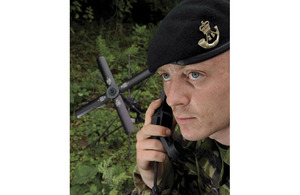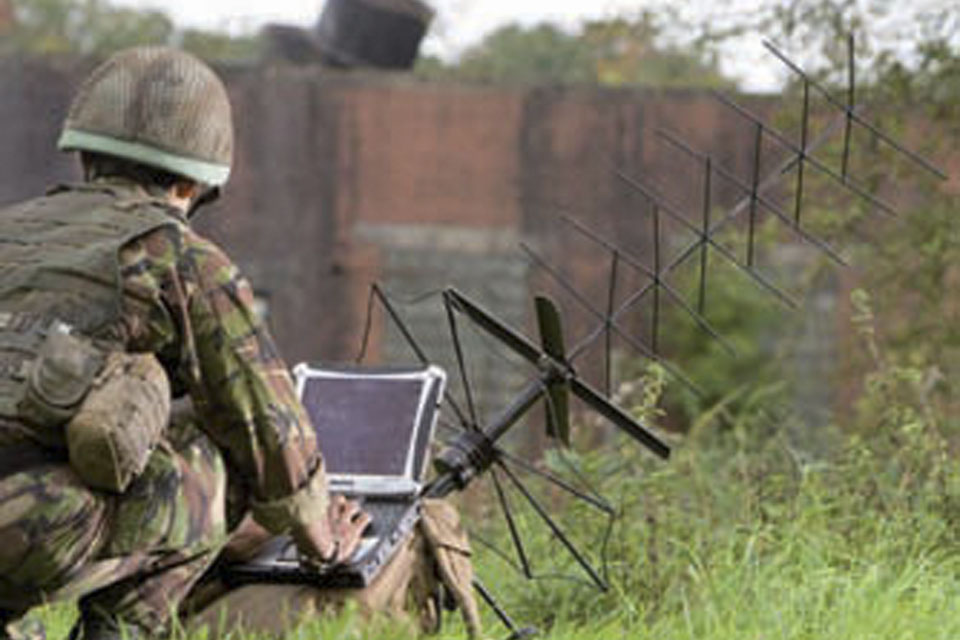Training tactical radio teams to speed up casualty extraction in Helmand
Following requests directly from the Helmand front line, tactical radio teams are being trained in specialised skills to increase the speed of casualty extractions from combat zones.

A Tac Signaller making use of the latest in antenna technology [Picture: Mike Weston and Staff Sergeant Will Craig, Crown Copyright/MOD 2010]
In line with the new initiative, soldiers from 1st Battalion The Rifles (1 RIFLES) have been recently trained on the pilot Tactical - or Tac - Signaller Course.
Speaking at the Caerwent proving area in Wales, Sergeant James Nicholl, Royal Signals Infantry Support Team, 1 RIFLES, explained the thinking behind the four-week programme:
The requirement was driven by realities on the ground in Afghanistan - it’s all about the speed of extraction from the field,” he said.
We’ve had improvements in communications equipment and now the Tac Signallers will bring faster, more accurate information to the unit.
The decision to draft in specialist radio operators will allow section commanders to focus on winning the firefight and planning the next move rather than dealing with communications traffic:
The section commander has more time to plan the extraction because the Tac Signaller deals with the liaison with medics and setting up a landing area for the Medical Emergency Response Team [MERT],” said Sgt Nicholl.
During the intense course, soldiers were thoroughly tutored on top-of-the-range communications kit that allows them to speak directly to support units such as mortar teams and casualty evacuation helicopters.
A major enhancement to the equipment is the 117 Harris radio - previously only used for special operations - which is now with every battalion in Afghanistan:
These radios are on VHF, UHF and satellite channel, and with a tactical satellite it’s not line-of-sight, you just have to hit a satellite and you’re in contact,” said Sgt Nicholl.
Tac Signallers can go straight to the baseline without going through the whole communication chain.
Someone in Kandahar with our channel can listen to us in deepest Helmand or wherever else we are as long as we hit a satellite.
Before deploying to Afghanistan next year, 1 RIFLES hope to have trained 50 Tac Signallers, giving each patrol access to the skill-set.
The concept is now being evaluated across the Army and may be rolled out to other infantry battalions via their respective Royal Signals support teams.

State-of-the-art technology, including the latest antennae and ruggedised laptops, makes life much easier for Tac Signallers [Picture: Mike Weston and Staff Sergeant Will Craig, Crown Copyright/MOD 2010]
As well as dealing with radios, Tac Signallers are trained in emergency first aid, enabling them to provide full-time medical teams with crucial details on the condition of casualties:
As trained medics they can treat a casualty, send off all the important information and direct the MERT in,” said Sgt Nicholl.
It’s not just a case of being able to use a radio - they must be fit, strong, robust, intelligent and able to have a calmness in the heat of battle.
One of the soldiers selected for the course’s groundbreaking first run was Rifleman Steven Pike.
After dealing with a casualty and calling in a helicopter while under simulated enemy fire during an exercise serial, he said:
This has given me an insight into the radios on the ground. The fact that a Tac Signaller can call in everything for everyone will really help to speed things up and make it quicker to extract casualties.
As well as speeding up the casualty evacuation process, the soldiers’ technological prowess will add to the intelligence armoury of the infantry battalion.
Along with their multi-channel radios, they will carry ruggedised high performance wave (HPW) laptops with the ability to send information back to base or wherever else it is required:
You can take a picture of a bad guy out on the ground and send it wherever you want in the world via the HPW,” said Sgt Nicholl.
So if you’re out on patrol you can send back information and images to the FOBs [forward operating bases] or main base allowing them to build up an intelligence picture. This is the top standard of kit we are working with.
Those chosen to become Tac Signallers will carry heavier loads and take on more responsibility than most of their colleagues on patrol.
But rather than see their role as a burden, these expertly-trained soldiers realise they will be saving lives and are ready and willing to make a positive difference to the Army’s front line operations.